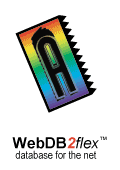
click here to return to the menu
Denim was....
- the culmination of two years of web database experience.
- an application framework for the web built on standard tools.
- a web interface designed for the user experience.
It became much, much more.
Over the intervening years, Denim (like all living systems) has evolved. The transformation was slow at first, as the framework was pressed into service building highly functional, user friendly web applications for engineering firms in West Palm Beach, Florida and Detroit, Michigan. Later, the framework was again employed to solve critical business data distribution needs for one of the world's leading conservation organizations headquartered in Arlington, Virginia. And it was at this juncture, a highly evolved Denim took on the name "WebDB".
The renaming was appropriate for two reasons. While Denim had been an application framework used by Andelain programmers that had no specific task, WebDB was now an application in it's own right. And WebDB said exactly what the new application was all about. Denim had become a full-fledged web-enabled database system.
Even in it's earliest stages, WebDB was highly configurable due to it's table driven design. It handled a variety of intrinsic data types ranging from text fields to file attachments. It allowed for a presentation layer that could take advantage of the web browser's native input controls, frame layouts, and multi-windowed environment. WebDB was employed to track land holdings, office documents, development registries and even it's original Denim purpose of distributing accounting data. WebDB even allowed for a psuedo-relational model to be employed at a West Palm Beach, Florida childern's agency to track services and the related children, activities and referrals.
But something was missing...
WebDB employed a flat database model and the limits of it's abilities were about to be reach. So WebDB evolved again, into WebDB2.
While WebDB could easily handle many flat tables of information, customization of underlying code by Andelain was required to achieve even the psuedo-relational model. WebDB2 changed all that. Almost any number of databases could hold both parent and related child tables. All without code modification. Even at version 2.0, WebDB2 was an impressive system. Not only were images added as an available data type (complete with systems generated previews and thumbnails) but standard reports fully supporting the relational model were now a part of the basic system. And like all good systems, WebDB2 had room to grow.
While being employed as an asset management system at a utility company in Palm Beach Gardens, Florida, a need arose to track a variety of facilities in a more hierarchial manner. WebDB2 with flex™ technology was born. Simple in concept, WebDB2flex™ allowed for a tree-like view of the parent table to assist the user in defining and locating data. Each parent record (or "node") can have a nearly unlimited number of descendant nodes, to a depth of nearly twenty levels. Each node (as a fully qualified parent record) could have it's own set of child table records. The ability of an organization to track their data and assets in user-organized, hierarchial view, was now possible.
During 2004, WebDB2flex™ continued to add features to enhance both the end-user's and the administrator's experience with WebDB2flex™. A partial list of features now available in the core WebDB2flex™ package include:
- built on industry-standard tools.
- integrated security model updateable through a web interface.
- full relational (parent-child) model.
- uses any odbc data source including jet MDB files.
- multiple data types including attached files and images.
- client-side validation of user input data.
- standard reporting and exporting capabilties.
- user preferences for appearences.
- elaborate filtering capabilites available to the user.
- full text search persistent throughout browsing, reporting and exporting.
- no client-side plug-ins or pesky Java applets.
In short, having reached version 2.6, WebDB2flex™ has evolved into the premiere web-enabled database system.
Until now.